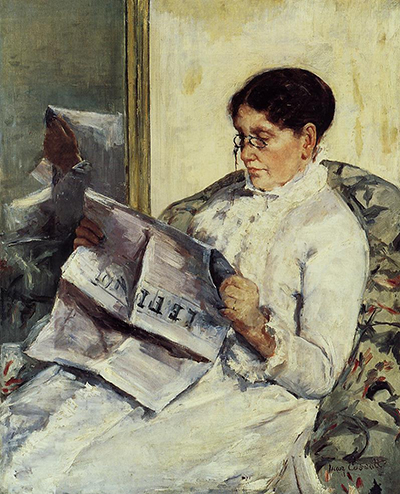In the painting, the artist's model – her mother – is perusing a newspaper. While the background is merely sketched in – a rather uninteresting room, leading into another, the model is sitting on a patterned chair – Cassatt clearly spent a great deal of time on her mother's face.
Even her clothing, which is perfectly proportioned, seems to have been hastily added, the lace ruffle of the bodice suggested with a wobbly line of a brush, frills at collar and cuffs similarly handled, and the whole seeming to have be laid down with a kind artless, hasty skill. The face, in sharp contrast is clear and realistic – almost photographically so. Should one see the model walking about today, she would be instantly and clearly recognisable: such is the skill with which Cassatt has rendered her mother's visage.
The two were known to be close, and it is certain that Cassatt would probably have been able to paint her mother from memory alone: so the vivid rendering is understandable – but no less deserving of sheer admiration. This work can be found in the Washington National Gallery of Art, the oil on canvas having been lent to that institution by an anonymous benefactor.
Painted in 1878, just as Mary Cassatt's artistry was coming to full fruition, but before she fully embraced the Impressionist movement – she was religiously submitting paintings to the Academy each year, but increasingly becoming embittered as she saw how unfairly the system was stacked against various groups of artists: unknowns tended to be rejected, women's art was considered beneath consideration – unless, of course, she had a worthwhile patron or ally! – poorer painters, those from outside society, those who were not 'one of us': all had to struggle much harder for recognition by that august body, even if their art was vastly superior to those few feted painters who had been to the right school, or who banked at the right place...
It is widely felt that this painting, 'Reading Le Figaro' is one of Cassatt's best works. This may be because she had recently completed a series of master-classes with recognised artistic experts: Jean-Leon Gerome, who specialised in hyperrealistic depictions, Charles Joshua Chaplin, a genre artist; and Thomas Couture who was perhaps responsible for Cassatt learning how to capture more informal moments of time in her works, rather than producing carefully posed and arranged works, like many other artists of the day.
Shortly after producing this work, her confidence allowed her to follow her friend and mentor, Edgar Degas, into the new and exciting world of Impressionism, sure that her skills were not lacking, and that they system was, indeed, stacked against her.




